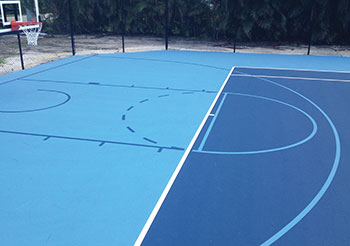
Adding Recreational Amenities to Your Community
by Trimmer Dettor / Published May 2015
With an ever-growing focus on healthy living and exercise, you are likely experiencing increased interest from your residents in adding new recreational amenities to your community. In order to be prepared, we will walk you through the steps you will need to take in order to intelligently consider these requests. Today, we will focus our discussion on planning for the addition of a new, asphalt (hard) tennis court. However, the process outlined here for building a new tennis court is applicable if you are interested in adding other recreational amenities including basketball courts, pickleball courts, bocce courts, shuffleboard courts, and putting greens. Let’s cover the necessary steps that are crucial to turning the dream of a new tennis court at your community into a reality.
The first component in the planning process is to determine if you have enough space to build a new court. The standard dimension of a new tennis court is 60 feet wide by 120 feet long, or 7,200 square feet. So, using your facility’s property survey, see if you have 7,200 square feet of space to build your new court. In addition to having this space, the court will need to be set back from property lines by 10–20 feet or more depending on your local zoning regulations. Therefore, your second step in planning is taking your site plan, with the new court sketched in, to the local zoning authorities to get preliminary approval for the location. If the planned location for your new court meets regulations, then it’s time to focus on the court specifications.
What type of court surface, hard or soft, is right for your community? What other key elements do you want to add to enhance the playing experience for your residents? You will need to consider fencing, shade, lighting, seating, court accessories, and drinking water. We recommend working closely with a local tennis court builder to review your options and develop your court specifications. Once your specifications are set, your tennis court contractor should be able to provide a very accurate budget for the court, fencing, lighting, and accessories. We recommend working with experienced tennis court contractors that are also state licensed General Contractors and have at least one Certified Tennis Court Builder on staff. Be sure to closely check references and take the time to visit some recent projects completed by your tennis court contractor.
Once the specifications and cost for the tennis court are known, it’s time to get clarity on the other costs you will incur to complete the project. Here are some of the additional items and costs you will need to consider:
• Fees associated with acquiring updated, certified copies of your site survey
• Local municipality permit fees
• Electrical fees (if you are adding lights)
• Fire code fees are possible, if you are adding a shade structure or windscreens
• Based on a budget figure of constructing a standard, asphalt tennis court with lights valued at $60,000, you can expect to pay +/- $2,000 in permit fees (typically the builder will pull the permit and bill the owner direct)
SITE WORK
• Soil testing, site preparation, grading, and drainage—site contractors are responsible for providing the tennis court contractor with a “ready to build” site with the four corners of the court area clearly marked, including finished elevations.
• Plumbing work may be required to run water from your existing system to the court.
• Electrical work may be required to run electric lines from your existing panel to the courts for lighting.
• Electrical work may be required to increase available power for lighting.
• Finished landscaping will be required outside the court.
POST-CONSTRUCTION MAINTENANCE
• Regardless of the type of court surface chosen, some post-construction maintenance and repairs will be required.
• Your tennis court contractor should be able to provide daily, weekly, monthly, and annual maintenance budgets for each type of court they build.
If you follow the process outlined above, you should be able to compile a fairly accurate budget for adding a new tennis court at your facility. You will then be armed with the information your residents need to make an informed decision about whether to move forward with the project.
Trimmer B. Dettor, Vice President and Owner
Fast-Dry Corp
Trimmer B. Dettor, Vice President and Owner of Fast-Dry Corp., grew up playing tennis and building courts. His father started Fast-Dry Corporation in 1981, and the company has grown into a full-service operation to include tennis court construction, resurfacing, and supplies. Trimmer joined Fast-Dry Corporation in 2002 and was responsible for all aspects of the day-to-day operations of the tennis court supplies division. In 2010, Trimmer switched over to the construction side of the business where he currently is an account executive and runs the hard court division. For more information, e-mail trimmer@fast-dry.com, call (800) 432-2994, or visit www.Fast-Dry.com.




